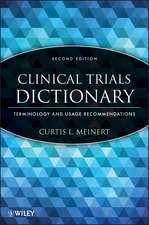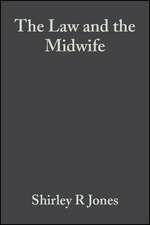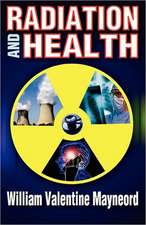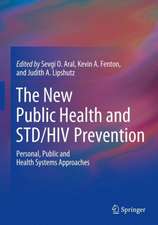Threats to Homeland Security – Reassessing the All–Hazards Perspective, Second Edition
Autor RJ Kilroyen Limba Engleză Paperback – 14 mai 2018
Preț: 914.08 lei
Preț vechi: 962.19 lei
-5% Nou
Puncte Express: 1371
Preț estimativ în valută:
174.90€ • 183.11$ • 144.73£
174.90€ • 183.11$ • 144.73£
Carte tipărită la comandă
Livrare economică 05-19 aprilie
Preluare comenzi: 021 569.72.76
Specificații
ISBN-13: 9781119251811
ISBN-10: 1119251818
Pagini: 576
Dimensiuni: 178 x 248 x 38 mm
Greutate: 1 kg
Ediția:2nd Edition
Editura: Wiley
Locul publicării:Hoboken, United States
ISBN-10: 1119251818
Pagini: 576
Dimensiuni: 178 x 248 x 38 mm
Greutate: 1 kg
Ediția:2nd Edition
Editura: Wiley
Locul publicării:Hoboken, United States
Public țintă
Introductory text on homeland security for educators, as well as a source for training for professionals in a number of homeland security–related disciplines to include: public safety and law enforcement; environmental health; emergency management; national security, defense, and intelligence; security management and consulting; and educators at all levels.Programs of study at community colleges, as well as four–year colleges include: law enforcement; emergency management; risk assessment and analysis; political science; criminal justice; security studies; interdisciplinary studies; environmental health; cybersecurity and information systems; intelligence and defense studies; critical infrastructure protection; and security management.
Cuprins
Notes on Contributors xiii Preface xvi Acknowledgments xxiii 1. The Changing Nature of National Security 1 Introduction 2 1.1 Foundations of American Security Policy 2 1.1.1 Geopolitics at the Beginning of the Twentieth Century 3 1.1.2 National Security and World War II 6 Self-Check 8 1.2 Security in the Cold War Era 8 1.2.1 Bipolarity versus Multipolarity 10 1.2.2 Containing Communism 12 1.2.3 Non-Communist Threats 16 Self-Check 17 1.3 Security in the Post-Cold War Era: Pre-9/11 17 1.3.1 Changing Threats 18 1.3.2 New Conflicts, New Responses 18 1.3.3 Reorganization of National Security Policy 20 Self-Check 21 1.4 National Security and Terrorism: Post-9/11 21 1.4.1 Globalization and Geopolitics 22 1.4.2 The Bush Administration's Global War on Terrorism 24 1.4.3 The Obama Administration's New National Security Strategy 26 1.4.4 Homeland Security and National Security 27 Self-Check 28 Summary 29 Key Terms 30 Assess Your Understanding 35 Summary Questions 35 Applying This Chapter 36 You Try It 37 2. Reassessing the All-Hazards Perspective 38 Introduction 39 2.1 Natural Disasters: Things We Can Expect to Happen 39 2.1.1 The History of Natural Disasters in the United States 40 2.1.2 Natural Disaster Response 41 2.1.3 Natural Disasters in a Post-9/11 World 44 Self-Check 46 2.2 Accidental Hazards: Things We Can Try to Prevent 46 2.2.1 History of Accidental Hazards in the United States 46 2.2.2 Accidental Hazard Prevention and Response 48 2.2.3 Accidental Hazards in a Post-9/11 World 50 Self-Check 51 2.3 Man-Made Hazards: Things We Hope Don't Happen 51 2.3.1 History of Man-Made Disasters Caused by Human Error in the United States 52 2.3.2 Man-Made Disaster Mitigation and Response 53 2.3.3 Man-Made Disasters in a Post-9/11 World 55 Self-Check 56 2.4 Reassessing the All-Hazards Perspective and Disasters 56 Self-Check 59 Summary 59 Key Terms 60 Assess Your Understanding 62 Summary Questions 62 Applying This Chapter 63 You Try It 64 3. Us Homeland Security Interests 65 Introduction 66 3.1 What Is Homeland Security? 66 3.1.1 The Merging of Traditions 67 3.1.2 Prevailing Homeland Security Theories 71 Self-Check 76 3.2 Additional Context for Homeland Security 77 3.2.1 Urban Versus Rural 77 3.2.2 Technologies 78 3.2.3 Political and Economic Factors 79 3.2.4 Security Versus Civil Liberties 81 Self-Check 84 3.3 Homeland Security Enterprise 84 3.3.1 Federal Partners 85 3.3.2 State and Local Partners 90 3.3.3 Whole Community Partners 91 Self-Check 97 3.4 Revisiting the All-Hazards Approach 98 Self-Check 100 Summary 101 Key Terms 101 Assess Your Understanding 105 Summary Questions 105 Applying This Chapter 106 You Try It 108 4. Understanding Threat Assessments 109 Introduction 110 4.1 Background on Threat Assessments and Risk Management 111 4.1.1 Risk Management and Threat Assessment from the All-Hazards Perspective 111 4.1.2 Assessing Threats and Civil Liberties 113 4.1.3 Homeland Security Risk Management Doctrine 114 Self-Check 116 4.2 A General Framework of Analysis: What to Assess 116 4.2.1 The Disaster Impact Process 117 4.2.2 Pre-Impact Conditions 117 4.2.3 Event-Specific Conditions 120 4.2.4 Final Thoughts on What to Assess 122 Self-Check 122 4.3 A Matrix Approach: How to Assess 123 4.3.1 Risk Matrices 124 4.3.2 Composite Exposure Indicator 127 4.3.3 HAZUS 128 4.3.4 Vulnerability Assessments 128 4.3.5 Threat and Hazard Identification and Risk Assessment 129 4.3.6 Final Thoughts on How to Assess 130 Self-Check 133 4.4 The Whole-Community Approach of the National Preparedness System 133 4.4.1 Prevention 136 4.4.2 Protection 137 4.4.3 Mitigation 137 4.4.4 Response 139 4.4.5 Recovery 140 Self-Check 143 Summary 144 Key Terms 144 Assess Your Understanding 148 Summary Questions 148 Applying This Chapter 148 You Try It 150 5. Critical Infrastructure Security, Emergency Preparedness, and Operational Continuity .151 Introduction 152 5.1 Defining Critical Infrastructure 152 5.1.1 Defining the Sectors 153 5.1.2 Information Sharing and Analysis Centers 154 Self-Check 157 5.2 Known Threats to Critical Infrastructure 157 5.2.1 Natural Hazard Threats 158 5.2.2 Terrorism and Human Threats 162 5.2.3 Nontraditional Aviation Technology (NTAT) 165 5.2.4 Cybersecurity Threats 166 Self-Check 168 5.3 Risk Identification, Analysis, and Management 169 5.3.1 Inventory and Critical Assets and Functions 169 5.3.2 Intelligence Functions .171 Self-Check 175 5.4 Emergency Operations and Continuity of Planning 175 5.4.1 Critical Infrastructure Protection Planning and the All-Hazards Perspective 175 5.4.2 Crisis Management Team 177 Self-Check 178 Summary 178 Key Terms 179 Assess Your Understanding 181 Summary Questions 181 Applying This Chapter 181 You Try It 182 6. State Actors and Terrorism 183 Introduction 184 6.1 Defining Terrorism and Other Forms of Collective Violence 184 6.1.1 Legal Definitions of Terrorism 190 6.1.2 The Heyday of State-Sponsored Terrorist Groups 193 6.1.3 The End of the Cold War, Globalization, and the Decline of State Sponsorship 195 Self-Check 197 6.2 Contemporary State Sponsors of Terrorism 197 6.2.1 Iran 199 6.2.2 Sudan 201 6.2.3 Syria 203 Self-Check 205 6.3 International and Domestic Responses to State-Sponsored Terror 205 6.3.1 United Nations Security Council (UNSC) 205 6.3.2 Other Multilateral Efforts 206 6.3.3 US International Counterterrorism Strategy 208 Self-Check 210 Summary 211 Key Terms 214 Assess Your Understanding 216 Summary Questions 216 Applying This Chapter 217 You Try It 218 7. Non-State Actors and Terrorism 219 Introduction 220 7.1 Explaining the Different Types of Non-state Actors 220 7.1.1 Defining Violent Non-state Actors .220 7.1.2 Defining Non-state Terrorism 221 7.1.3 Terrorism and "Terrorists" 221 Self-Check 223 7.2 Non-state Terrorism as a Security Threat 223 7.2.1 Reasons for the Prevalence of Violent Non-state Actors 224 7.2.2 Non-state Terrorism as a Domestic and International Threat 225 7.2.3 Assessing the Threat Posed by Violent Non-state Actors 227 Self-Check 228 7.3 The Typology of Violent Non-state Actors 228 7.3.1 Political/Ideological Terrorism 231 7.3.2 Ethno-Nationalist or Separatist Terrorism 236 7.3.3 Religious Terrorism 240 7.3.4 Motivational Trends in Non-state Terrorism 247 Self-Check 248 7.4 Methods of Non-state Violence 248 7.4.1 Conventional and Unconventional Methods of Non-state Violence 249 Self-Check 255 7.5 International Strategies for Countering Non-state Violence 255 7.5.1 The Military Option 257 7.5.2 The Political Option 259 Self-Check 260 Summary 261 Key Terms 261 Assess Your Understanding 265 Summary Questions 265 Applying This Chapter 266 You Try It 267 8. Cyber-Crime, Cyber-Terrorism, and Cyber-Warfare 268 Introduction 269 8.1 The Cyber Threat 269 8.1.1 Defining Cyber-Crime, Cyber-Terrorism, and Cyber-Warfare 271 8.1.2 What Can Cyber-Crime, Cyber-Terrorism, and Cyber-Warfare Do? 272 Self-Check 275 8.2 8.2 Assessing Capability and Intent 275 8.2.1 Who Can Conduct Cyber-Crime, Cyber-Terrorism, and Cyber-Warfare? 275 8.2.2 Tools of Cyber-Terrorism 279 Self-Check 281 8.3 Assessing Consequences 281 8.3.1 Why America Is Vulnerable to Cyber-Attacks 283 8.3.2 The Impact of a Cyber-Terrorist Attack 285 Self-Check 286 8.4 Determining Defenses against Cyber-Crime , Cyber-Terrorism, and Cyber-Warfare 286 8.4.1 The Government and Private Sector Response to Threats in Cyberspace 288 8.4.2 The US Military Response to Cyber-Warfare 291 8.4.3 The New Battlefields of Cyber-Warfare 295 Self-Check 296 Summary 296 Key Terms 297 Assess Your Understanding 301 Summary Questions 301 Applying This Chapter 302 You Try It 303 9. Weapons of Mass Destruction and Disruption 304 Introduction 305 9.1 Chemical Weapons and Their Consequences 305 9.1.1 History of Chemical Weapons Use 307 9.1.2 Chemical Agents and Their Effects 308 9.1.3 The Threat of Chemical Weapons and Terrorism 311 Self-Check 313 9.2 Biological Weapons and Their Consequences 313 9.2.1 History of Biological Weapons Use 313 9.2.2 Biological Agents and Their Effects 315 9.2.3 The Threat of Biological Weapons and Terrorism 316 Self-Check 319 9.3 Nuclear and Radiological Weapons and Their Consequences 319 9.3.1 Radiological Materials and Their Effects 321 9.3.2 History of Nuclear Material Discoveries and Weapons Development 323 9.3.3 The Threat of Nuclear Weapons and Terrorism 324 9.3.4 Managing Radiological Incidents and Their Aftermath 327 Self-Check 329 Summary 329 Key Terms 330 Assess Your Understanding 332 Summary Questions 332 Applying This Chapter 333 You Try It 334 10. Domestic Terrorism 335 Introduction 336 10.1 Terrorism in the United States: Across Time and Space 337 10.1.1 Eighteenth- to Twentieth-Century Terrorism 337 10.1.2 Late Twentieth-Century Terrorism 339 10.1.3 Early Twenty-First-Century Terrorism 340 Self-Check 344 10.2 Homegrown "Leaderless Resistance" and Foreign Terrorists 344 10.2.1 Understanding Leaderless Resistance 345 10.2.2 Origins of Lone Wolves 346 10.2.3 Assessing the Lone-Wolf Threat in the United States 347 10.2.4 Foreign Terrorist Organizations 349 10.2.5 Foreign Organizers 350 Self-Check 352 10.3 Crime and Terrorism 353 10.3.1 Why Would Terrorism and Crime Converge? 353 10.3.2 Where Terrorism and Crime Converge and Why It Matters 354 Self-Check 356 10.4 The US Domestic Response to Terrorism 356 10.4.1 Countering Violent Extremism (CVE) 357 10.4.2 The Lead Agency Approach and Counterterrorism 359 10.4.3 Police and Counterterrorism 360 Self-Check 364 Summary 365 Key Terms 366 Assess Your Understanding 369 Summary Questions 369 Applying This Chapter 370 You Try It 371 11. Enablers of Mass Effects 372 Introduction 373 11.1 The Power of Information and Ideas 373 11.1.1 Ideas and Terrorism 376 11.1.2 Ideas and Disasters 378 Self-Check 381 11.2 Media and Terrorism 381 11.2.1 The Internet and Terrorism 382 11.2.2 Social Media, Terrorism, and Disaster Response 386 Self-Check 395 11.3 The Role of Educational Institutions 395 11.3.1 Alternative Educational Institutions 396 11.3.2 International Students in the United States 396 Self-Check 399 Summary 399 Key Terms 400 Assess Your Understanding 402 Summary Questions 402 Applying This Chapter 402 You Try It 404 12. Homeland Security Intelligence 405 Introduction 406 12.1 Intelligence and Homeland Security 406 12.1.1 NYPD Surveillance of Muslim Communities 406 12.1.2 What Is Intelligence? 407 12.1.3 The Limited Historical Role of Intelligence in Domestic Affairs 411 Self-Check 412 12.2 The Structure of Intelligence Organizations 412 12.2.1 National-Level Intelligence Organizations 414 12.2.2 The Department of Homeland Security and Intelligence 418 12.2.3 State, Local, and Tribal Government 420 12.2.4 The Private Sector 422 12.2.5 Intelligence Collaboration 423 Self-Check 427 12.3 Methods of Collecting Intelligence Information 427 12.3.1 Human Intelligence Collection 429 12.3.2 Open-Source Intelligence Collection 430 12.3.3 Technical Intelligence Collection .432 Self-Check 436 12.4 Challenges to Homeland Security Intelligence 436 12.4.1 Balancing Liberty and Security in Homeland Security Intelligence 437 12.4.2 Intelligence Support to Disaster Relief 440 Self-Check 441 Summary 441 Key Terms 443 Assess Your Understanding 446 Summary Questions 446 Applying This Chapter 447 You Try It 448 13. Homeland Security Planning and Resources 449 Introduction 450 13.1 Basics of Homeland Security Planning 450 13.1.1 Planning for Homeland Security Activities 451 13.1.2 Quadrennial Homeland Security Review 452 13.1.3 Expanding on the QHSR: The DHS Strategic Plan 454 13.1.4 Final Thoughts on the QHSR 456 Self-Check 457 13.2 Coordinating Homeland Security Planning 457 13.2.1 The Six-Step Planning Process 458 13.2.2 Performance Measurement: The Challenging "Art" of Measuring Success in Homeland Security Planning 461 13.2.3 SMART Measurement 462 Self-Check 463 13.3 The Logic Model: A Process Framework to Visually Demonstrate the Performance Measurement Process 463 13.3.1 Components of a Logic Model 464 13.3.2 Challenges in Performance Measurement 467 Self-Check 467 13.4 Education in Homeland Security .468 13.4.1 Homeland Security Education Core Curricula 468 13.4.2 Research in Homeland Security: Trends and Future Thoughts 471 Self-Check 473 Summary 473 Key Terms 474 Assess Your Understanding 476 Summary Questions 476 Applying This Chapter 476 You Try It 478 References 479 Index 538










